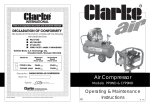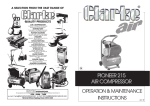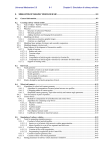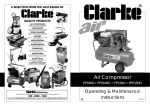Download Product Manual
Transcript
Air Compressor Models: CFP9HND Operating & Maintenance Instructions © 0614 -2- WARNING! DO NOT ATTEMPT TO ALTER ENGINE SPEED SETTINGS DOING SO WILL INVALIDATE YOUR GUARANTEE SPECIFICATIONS CFP9ND Part Number 2090901 Engine Type HONDA Pump Type MK238 Air Receiver size 2.65litres Max. output Pressure 100psi Air Displacement 9cfm Outlet connectors 1/4” BSP Dimensions (mm) 520x360x440 Weight (kg) 21 G’teed Sound Power Level** 96.5dBLWA ** See Declaration of Conformity on Back Cover NOTE: Specifications are correct at the time of going to print. Clarke International reserves the right to change specifications at any time, as it sees fit, in the interests of safety or improvement in design. Copyright: Clarke International, All rights reserved. June,2002 -3- Read these safety instructions before using the equipment. INTRODUCTION Thank you for purchasing this Clarke Air portable compressor. The unit is powered by a 5HP Honda engine, a manual for which, is provided separately. Please refer to that manual for all matters relating to the engine, ...starting and stopping procedures, maintenance etc. GUARANTEE This product is guaranteed against faults in manufacture for 12 months from purchase date. Please keep your receipt as proof of purchase. This guarantee is invalid if the product has been abused or tampered with in any way, or not used for the purpose for which it is intended. The reason for return must be clearly stated. This guarantee does not affect your statutory rights. CONTENTS Page Introduction .................................................................................................................. 4 Guarantee .................................................................................................................... 4 For your Own Safety .................................................................................................... 5 Important General Notes ............................................................................................ 6 General Layout ............................................................................................................ 7 Preparation for Use ...................................................................................................... 8 Starting & Using your Air Compressor ....................................................................... 9 Shutting Down the Compressor ............................................................................... 10 Maintenance .............................................................................................................. 11 Troubleshooting ......................................................................................................... 12 Parts and Service Contacts ...................................................................................... 14 Parts Lists and Diagrams ...................................................................................... 15-17 Declaration of Conformity ........................................................................................ 18 - 4- FOR YOUR SAFETY WARNING As with all machinery, there are certain hazards involved with their operation and use. Exercising respect and caution will considerably lessen the risk of personal injury. However, if normal safety precautions are overlooked, or ignored, personal injury to the operator, or damage to property may result. It is in your own interest to read and pay attention to the following rules: General Precautions ALWAYS • ensure that all individuals using the compressor have read and fully understand the Operating Instructions supplied. • Stop the engine and ensure the pressure is expelled from the air receiver BEFORE carrying out any maintenance. • ensure that there is adequate ventilation when spraying flammable materials e.g. cellulose paint, and keep clear of any possible source of ignition. • protect yourself. Think carefully about any potential hazards which may be created by using the air compressor and use the appropriate protection. e.g.Goggles will protect your eyes from flying particles. Face masks will protect you against paint spray and/or fumes. Ear defenders will prevent hearing damage caused by load noise. • consult paint manufacturers instructions for safety and usage, before spraying • ensure that the air supply is turned off at the machine outlet and all pressurised air from the machine and other equipment attached to it, is expelled BEFORE disconnecting air hoses or other equipment. • make sure that children and animals are kept well away from the compressor and any equipment attached to it. • ensure that any equipment or tool used in conjunction with your compressor, has a safety working pressure exceeding that of the machine. NEVER • direct a jet of air at people or animals, and NEVER discharge compressed air against the skin. COMPRESSED AIR CAN BE DANGEROUS! • leave pressure in the receiver overnight, or when transporting. • adjust, or tamper with the safety valves. The maximum pressure is factory set, and clearly marked on the machine. • operate in wet or damp conditions. Keep the machine dry at all times. Similarly, a clean atmosphere will ensure efficient operation. Do not use in dusty or otherwise dirty locations. • touch the machine until it has cooled down...some of the metal parts can become quite hot during operation. • operate your compressor with any guards removed. -5- Fire Prevention ALWAYS • switch the engine OFF when refuelling. • refuel away from any source of heat. • refuel in a well ventilated area. NEVER • overfill the tank, fill to the level specified. • smoke whilst refuelling and avoid smoking or using a naked flame near the compressor. • start the engine if there is spilled fuel. Any spillage must be wiped clean and the compressor allowed to dry before attempting to start the engine. Exhaust Gas Precautions ALWAYS • ensure there is adequate ventilation when using the compressor. • position the compressor so that the exhaust is pointed away from people or animals . NEVER WARNING: Exhaust fumes can be fatal • Do not use the compressor indoors or in an enclosed area. (i.e. in a warehouse, tunnel, well, hold etc.) IMPORTANT General Notes • NEVER allow anyone, not fully familiar with compressors, to use this equipment. • DO NOT alter the engine settings....these settings are set at the factory. Should they need recalibration - consult your Clarke dealer -6- GENERAL LAYOUT CFP9ND Fig.1 -7- PREPARATION FOR USE A.Environmental • Ensure the compressor is sited on a firm level surface. • Ensure the environment is dry and dust free. • Ensure there is adequate ventilation for: a) Air intake to compressor pump b) Cooling for compressor pump c) Engine exhaust gases. B. Engine Check oil and fuel levels and a visual check of components. Refer to engine service manual. C. Pump • Check oil level on the Dipstick - to level marked. D. Fueling Fill with unleaded petrol, according to the instructions within the engine manual. • Ensure the fuel tap is set to the required position. • Ensure The fuel hose and connectors are intact, in perfectly servicable condition and there is no leakage. Note : Always use a funnel to fill the fuel tank so as to avoid accidental spillage of fuel. If fuel is spilled it must be removed from the unit and surrounding area, before attempting to start the engine. E. Receiver • Drain off any condensate, by opening the drain cock (see Fig. 1). Remember to close the cock when completed. NOTE: This should be carried out DAILY when the compressor is in constant use. F. Air Hose & Air Tool • Attach the air hose to the outlet using an appropriate connector. NOTE: Quick fit nuts are provided with model PP9ND • Attach the air tool/spray gun to the air hose...If using snap couplings, use a whip end, available from your Clarke dealer. -8- STARTING AND USING THE COMPRESSOR First time startup NOTE: For first time operation, do not connect the air hose or any tools and proceed as follows: 1. 2. 3. Start the engine, according to the instructions contained in the engine service manual, and allow to run for 10 minutes. Fig.2 After a ten minute period, stop the engine and attach an air hose to the air outlet and the tool. Screw the pressure regulator fully anticlockwise, then restart the engine and allow presure to build up in the receiver. Screw the pressure regulator clockwise until the pressure, registered on the Pressure Gauge, is 100psi. At this point, check the system for air leaks. If any are apparent, stop the engine and operate the tool until the air pressure is at zero, or open the drain cocks before rectifying. NOTE: Air will blow off at the bleed hole when the pressure reaches 100psi, which is the MAX. operating pressure. 4. With the engine running, turn the pressure regulator so that your desired pressure is registered on the gauge, and proceed to use the air tool in accordance with the manufacturers instructions. When starting subsequently, start the machine as follows: 1. At the begining of the day, open the drain cocks (see Fig.1) and allow any condensate to drain completely, then close the cocks. 2. Connect the air hose to the air outlet and tool, and set the pressure regulator to zero pressure (turned fully anticlockwise). 3. Start the engine in accordance with the instructions contained in the engine service manual, and allow pressure to build up. 4. When the pressure in the receiver has built up and air blows off at the bleed hole, turn the outlet pressure regulator clockwise so that the desired pressure is registered on the pressure gauge and proceed to use the air tool/spray gun. 5. Check for air leaks at the tool and connectors...as above, before proceeding. -9- STOPPING THE COMPRESSOR At the end of the day, stop the engine in accordance with the instructions in the engine manual, then open the drain cock. 1. Turn the regulator fully anticlockwise. 2. Operate the air tool trigger or operating lever etc., to ensure there is no pressure in the air line, then disconnect airline and tool. DO NOT under any circumstances attempt to remove the air tool or disconnect the air hose until you are satisfied that the pressure has been relieved. 3. Finally, close the drain cock. Take care not to touch the engine or pump as they remain hot for some time after use. - 10 - MAINTENANCE DAILY a. Drain Air Receiver of any condensate b. Check engine oil level and top up where necessary. Ensure the dipstick breather hole is not blocked. c. Check pump oil level WEEKLY a. Clean Pump Filter 1. Turn Pump Filter cover and pull away to reveal paper element. If badly contaminated, replace. Remove any loose contaminants if any then replace. b. Clean the engine cooling fins. 6 MONTHLY Renew pump lubricating oil. and Fig.3 Make sure the cylider head bolts are tight (see below) Drain pump by removing the drain screw (Arrowed in Fig.3). Replace screw and top up until oil is level with the mark on the dipstick, using SAE30 oil available from your Clarke dealer as follows: Part No. 3050801 In addition to the above, check the engine manual for service schedule. Repairs should only be carried out by a qualified engineer. If problems occur, contact your Clarke dealer. Torque values for cylinder head bolts Torque Vaule (NM) MODEL NUMBER 8.8 - 9.3 PP9ND, CFP9HND - 11 - TROUBLE SHOOTING CHART IMPORTANT 1. Any remedial work that may be required must be carried out by a qualified engineer. 2. Switch off the engine before removing any parts from the compressor. 3. Drain the Air Receiver before dismantling any part of the compressor unit’s pressure system. 4. If your compressor develops a fault do not use until the fault has been rectified. 5. For troubleshooting the engine, refer to the engine manual. SYMPTOM Engine difficult to start PROBABLE CAUSE Load Genie leaking (compressor unit is on load during start). Stop engine and empty air receiver. Clean or replace Load Genie Load Genie valve blocked, possibly frozen up. Thaw Load Genie out (Unit must be installed in frost-free place). Compressor unit Load Genie defective. constantly ‘on load’ Compressor constantly ‘on load’ and cannot attain the working pressure required. REMEDY Have Load Genie serviced or replaced Load Genie set at a pressure higher than the safety valve’s opening pressure. Contact Clarke Service Department Load Genie leaking. Contact Clarke Service Department Suction filter blocked. Clean / Change filter. Leak between compressor block and air receiver leaks in or near air receiver. Tighten connection and repair leak. Valves blocked by dirt, paint, dust or choked up. Contact Clarke Service Department Inspection cover or drain plug leaking. Empty air receiver and change seals/plugs. Pressure gauge defective. Change pressure gauge. Unit too small in relation to air consumption. Use a larger capacity compressor Compressor worn. Have compressor overhauled or replace it. - 12- Unusual noise from compressor. Bolts loose. Tighten bolts. Flywheel loose. Tighten flywheel. Unit installed on an unsuitable base. Move unit to a more solid base. Bearings, piston rings or cylinder worn. Contact Clarke Service Department Contact Clarke Service Department Valve broken. Compressor becomes too hot. Insufficient ventilation. See that sufficient air is supplied to flywheel or fan of compressor and that hot air is properly vented. Oil level too low (check 2 or 3 times after stopping). Fill with oil – see Page 10. Fault in valves (machine not stopping). Contact Clarke Service Department Blown head gasket (machine not stopping). Contact Clarke Service Department Dirt on cooling fins or suction filter. Clean cooling fins and suction filter. Unit working at too high a pressure. Contact Clarke Service Department Non-return valve partly Clean or that out non return valve. blocked. Connect to a supplementary compressor or install a larger model. Compressor being overworked and running continuously. - 13 - Compressor unit runs Large amount of condensation on and off load more in air receiver. frequently than usual. Leaks in system Drain off condensation Regularly (Every day before use). Leaks in system. Compressor unit runs ‘on load’ when no air is being used. Locate leaks (by means of soapy water) and repair. Compressor’s oil consumption rising. Too much oil in compressor. Check oil level 2 or 3 minutes after stopping. Leaks around crank case. Contact Clarke Service Department Working temperature of compressor too high because of insufficient cooling. Increase ventilation to air compressor. Cylinder worn. Contact Clarke Service Department Intake air filter blocked. Clean or replace Sump over full. Reduce oil to correct level. Cylinder worn. Contact Clarke Service Department Intake air filter blocked. Clean / Change air filter. Condensation in oil pump. Compressor over dimensioned. Oil in the air delivered. Oil level rises although no oil has been put in. Condensation at outlet Piping installation incorrect. points. Compressor taking in air which is too warm. Locate leaks (by means of soapy water) and repair. Consult your local dealer. Obtain better fresh-air supply to compressor. For Spare Parts and Service, please contact your nearest dealer, or CLARKE International, on one of the following numbers. PARTS & SERVICE TEL: 020 8988 7400 PARTS & SERVICE FAX: 020 8558 3622 or e-mail as follows: PARTS: [email protected] SERVICE: [email protected] - 14 - PUMP PARTS - 15 - PUMP PARTS No. 1 2 3 4 5 6 7 8 9 10 11 12 13 14 15 16 17 18 19 20 21 22 23 24 25 26 27 28 29 30 31 32 33 34 35 36 37 38 39 40 41 Description Air Filter Assy ....................................................................... Head Bolt M6x45 ................................................................ Cylinder Head .................................................................... Spacer ................................................................................. Heat Shield ......................................................................... Screw M6x70 ...................................................................... Washer 6.5x18 .................................................................... Screw M5x15 ...................................................................... Elbow ................................................................................... Gasket ................................................................................. Valve plate ......................................................................... Gasket ................................................................................. Cylinder ............................................................................... Screw M8x20 ...................................................................... O-Ring ................................................................................. Piston Ring Set .................................................................... Piston ................................................................................... Gudgeon Pin ...................................................................... Circlip .................................................................................. Piston Complete ................................................................ Con-Rod ............................................................................. Dipstick ................................................................................ Washer ................................................................................ Screw M6x10 ...................................................................... End Casing ......................................................................... Screw ................................................................................... Gasket ................................................................................. Screw ................................................................................... Eccentric ............................................................................. Key ....................................................................................... Crankshaft .......................................................................... Bearing ................................................................................ Seal ...................................................................................... Crankcase .......................................................................... Casing ................................................................................. Screw M5x20 ...................................................................... Screw M5x25 ...................................................................... Fan ....................................................................................... End Casing ......................................................................... Shield ................................................................................... Gasket Kit ............................................................................ - 16 - Part No. FN317013000 FN014002021 FN116001001 FN116060015 FN116060016 FN014002029 FN014005044 FN014013042 FN011015000 FN116022009 FN116022100 FN116022010 FN116022001 FN014011064 FN010114000 FN216022002 FN116022004 FN116022040 FN015001000 FN416022004 FN116091021 FN012035000 FN010072000 FN014013024 FN016032014 FN014006083 FN116001025 FN014022001 FN116060005 FN116060006 FN116060001 FN033058000 FN010060000 FN116060011 FN116060003 FN014013046 FN014013045 FN016060002 FN116060004 FN116060010 FN216GA0001 PARTS LIST - ENGINE HS17211-ZL8-000 HS98079-56846 1. 1. HS28400-ZL8-013ZA 2. HS28462-ZL8003 RECEIVER AND ANCILLIARY PARTS No. Description Part No. CFP9HND 1 2 Pump MK 238 Engine Honda 5HP 1370005 Contact Spares Department 4 5 Drain Cock Bottom Entry Gauge 2000221 2000171 6 7 Safety Valve Manifold 4-way 2000192 FN011276000 8 9 Rubber Foot Regulator Assy FN116011006 FN347026000 10 Back Entry Gauge 11 1/2” Load Genie N/A N/A 12 15mm Wheel 13 Wheel Retaining Clip N/A N/A 14 Rubber Foot 15 Mini Filter Regulator N/A N/A 16 Manifold 3-way N/A - 17- - 19 -

























